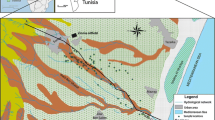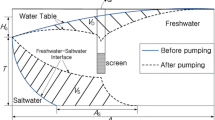Abstract
A new methodology is developed in assessing environmental impacts of desalination plants discharging brine into the ground. The main environmental problem of the desalination of seawater is the brine disposal. The brine is commonly discharged into the sea or injected into a saline aquifer. In the case of injection into the ground, it is necessary to design a disposal system in a way that respects the environment and is sustainable. Laboratory and computational methods have been utilized to simulate the unsteady three-dimensional (3D) phenomena of subsurface brine disposal. The computational software used is SEAWAT, which is a 3D unsteady variable-density flow simulation model. The model is first used to simulate the laboratory results, and good agreement is achieved. Then, hypothetical problems are designed and simulated of groundwater extraction and brine disposal by desalination stations. The major purpose of these hypothetical problems is to delineate a methodology and to create design charts for design and management of production and injection well fields for coastal desalination plants. Several design charts have been developed with 36 scenarios for two well configurations created by four design parameters: relative salt concentration (RSC), production and injection rates (Q d , Q r ), well spacing (S), and simulation period (T).













Similar content being viewed by others
References
Abou Rayan M, Djebedjian B, Kkaled I (2001) Water supply and demand and desalination option for Sinai, Egypt. Desalination 136:73–81
Aboufayed A, Elghuel M, Rashed M (2002) Desalination: a viable supplemental source of water for the arid states of North Africa. Desalination 152:75–81
Allam A, Saaf E, Dawoud M (2002) Desalination of brackish groundwater in Egypt. Desalination 152:19–26
Buros OK (2001) The ABCs of desalting, 2nd edn. Produced by the saline water conversion corporation for the International Desalination Association, Riyadh, Saudi Arabia
Gue W, Langeven CD (2002) User’s guide to SEAWAT: a computer program for simulation of three-dimensional variable-density ground-water flow. US Geological Survey open-file-report 01–434, p 79
Head KH (1992) Manual of soil laboratory testing: soil classification and compaction tests, vol 1. Wiley, New York, pp 70–78
Nassar M (2004) Design and management of discharge and recharge well fields for coastal desalination plants. M.Sc. Thesis, Faculty of Engineering, Cairo University, Giza, Egypt
US Congress, Office of Technology Assessment (1988) Using desalination technologies for water treatment. OTA-BP-O-46. US Government Printing Office, Washington, DC
Author information
Authors and Affiliations
Corresponding author
Rights and permissions
About this article
Cite this article
Nassar, M.K.K., El-Damak, R.M. & Ghanem, A.H.M. Impact of desalination plants brine injection wells on coastal aquifers. Environ Geol 54, 445–454 (2008). https://doi.org/10.1007/s00254-007-0849-9
Received:
Accepted:
Published:
Issue Date:
DOI: https://doi.org/10.1007/s00254-007-0849-9




